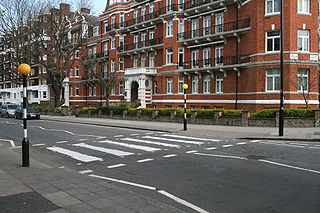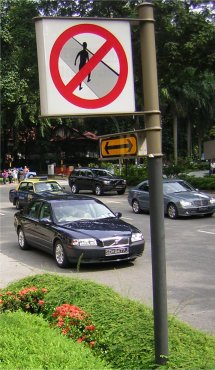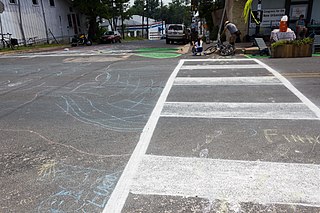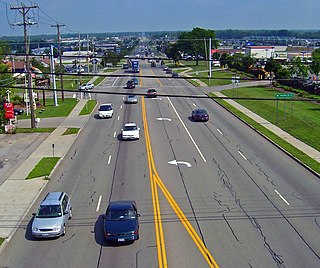
Traffic comprises pedestrians, vehicles, ridden or herded animals, trains, and other conveyances that use public ways (roads/sidewalks) for travel and transportation.

A zebra crossing or a marked crosswalk is a pedestrian crossing marked with white stripes. Normally, pedestrians are afforded precedence over vehicular traffic, although the significance of the markings may vary by jurisdiction. They are known as "zebra" crossings as the stripes resemble the coat of a zebra.

A pedestrian crossing is a place designated for pedestrians to cross a road, street or avenue. The term "pedestrian crossing" is also used in the Vienna and Geneva Conventions, both of which pertain to road signs and road traffic.

Jaywalking is the act of pedestrians walking in or crossing a roadway if that act contravenes traffic regulations. The term originated in the United States as a derivation of the phrase jay-drivers, people who drove horse-drawn carriages and automobiles on the wrong side of the road, before taking its current meaning. Jaywalking was coined as the automobile arrived in the street in the context of the conflict between pedestrian and automobiles, more specifically the nascent automobile industry.

A pedestrian scramble is a type of traffic signal movement that temporarily stops all vehicular traffic, thereby allowing pedestrians to cross an intersection in every direction, including diagonally, at the same time.

NYC Media is the official public radio, television, and online media network and broadcasting service of New York City, which has been called the media capital of the world. The network oversees four public television channels, a public radio station, and an Internet video on demand service.

Turn on red is a principle of law permitting vehicles at a traffic light showing a red signal to turn into the direction of traffic nearer to them when the way is clear, without having to wait for a green signal.

In traffic engineering, there are regional and national variations in traffic light operation. This may be in the standard traffic light sequence or by the use of special signals.

A HAWK beacon is a traffic control device used to stop road traffic and allow pedestrians to cross safely. It is officially known as a pedestrian hybrid beacon. The purpose of a HAWK beacon is to allow protected pedestrian crossings, stopping vehicular traffic only as needed. The HAWK beacon is a type of traffic control alternative to traffic control signals and/or where an intersection does not meet traffic signal warrants.
An embedded flashing-light system or an in-pavement flashing-light system is a type of device that is used at existing or new pedestrian crosswalks to warn drivers of oncoming pedestrian traffic. The device usually consists of LED lights that are embedded into the roadway alongside the crosswalk and are oriented to face oncoming traffic. When a pedestrian approaches the crosswalk, the system is activated and the LED lights begin to flash simultaneously. These lights are programmed to flash for a period of time that is sufficient for an average pedestrian to cross.
Road traffic control devices are markers, signs and signal devices used to inform, guide and control traffic, including pedestrians, motor vehicle drivers and bicyclists. These devices are usually placed adjacent, over or along the highways, roads, traffic facilities and other public areas that require traffic control.

A rainbow crossing or rainbow crosswalk is a pedestrian crossing that has the art of the rainbow flag installed to celebrate the LGBT community.
Road signs in Canada may conform to the Manual of Uniform Traffic Control Devices for Canada (MUTCDC) by the Transportation Association of Canada (TAC) for use by Canadian jurisdictions. Although it serves a similar role to the MUTCD from the US Federal Highway Administration, it has been independently developed and has a number of key differences with its American counterpart, most notably the inclusion of bilingual (English/French) signage for jurisdictions such as New Brunswick with significant anglophone and francophone population, and a heavier reliance on symbols rather than text legends.

Tactical urbanism, also commonly referred to as guerrilla urbanism, pop-up urbanism, city repair, D.I.Y. urbanism, planning-by-doing, urban acupuncture, and urban prototyping, is a low-cost, temporary change to the built environment, usually in cities, intended to improve local neighbourhoods and city gathering places.

A guerrilla crosswalk is a pedestrian crossing that has been modified or created without jurisdictional approval, and with the intent of improving pedestrian and other non-automobile safety. These interventions are a common strategy within tactical urbanism, a type of low-cost, often temporary change to the built environment intended to improve local livability. Guerilla crosswalks have been noted in news articles since at least 2009 and have become more well known as an urban strategy in recent years. The first known example of guerilla crosswalks can be found in Canada in 1987 when social activists John Valeriote and Erik Veldman created a crosswalk in Guelph, Ontario for students to safely cross a busy road in front of their school.
Lightguard Systems is a California traffic safety device company known for developing “Smart Crosswalk”, the earliest pedestrian safety system to use embedded pavement flashing-light systems.

A stroad is a type of thoroughfare that is a mix between a street and a road. Common in the United States and Canada, stroads are wide arterials that often provide access to strip malls, drive-throughs, and other automobile-oriented businesses. Urban planners have criticized stroads for their safety issues and poor efficiency. While streets provide access to shops and residences at safe traffic speeds, and roads can efficiently move traffic at high speed and volume, stroads pose dangers to drivers and pedestrians and are also prone to congestion.

A series of rainbow crossings have been painted in Seattle, in the U.S. state of Washington. According to The Seattle Times, the colorful pedestrian crossings "signal inclusiveness all year-round". Since the rainbow crossings were installed in 2015, more artistic crossings have appeared throughout the city.

In Seattle, in the U.S. state of Washington, pedestrian crossings are managed by several government agencies, including the Seattle Department of Transportation (SDOT). Since privately funded rainbow crossings were installed on Capitol Hill in 2015, SDOT has sanctioned the installation of more than 40 artistic crosswalks. Works include "rainbow stripes and geometric designs created by local artists", according to The New York Times. SDOT's Community Crosswalks program considers community proposals. Seattle has also seen residents create guerilla crosswalks.

Crosswalks in the United States and Canada are normally found at intersections, though sometimes may be found mid-block. Crosswalk installations must follow the regulations specified in the Manual on Uniform Traffic Control Devices (MUTCD). At signalized intersections, crosswalks may have pedestrian signals which display symbols to mandate when pedestrians may cross the street.

















